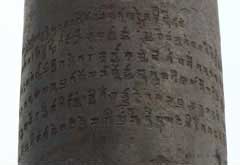There are plenty of source materials to reconstruct the history of the Gupta period. They include literary, epigraphical and numismatic sources. The Puranas throw light on the royal genealogy of the Gupta kings. Contemporary literary works like the Devichandraguptam and the Mudhrakshasam written by Visakadatta provide information regarding the rise of the Guptas. The Chinese traveler Fahien, who visited India during the reign of Chandragupta II, has left a valuable account of the social, economic and religious conditions of the Gupta empire.
 |
| Allahabad Pillar |
The coins issued by Gupta kings contain legends and figures. These coins provide interesting details about the titles and sacrifices performed by the Gupta monarchs.
Chandragupta I (320 – 330 A.D.)
The founder of the Gupta dynasty was Sri Gupta. He was succeeded by Ghatotkacha. These two were called Maharajas. Much information was not available about their rule. The next ruler was Chandragupta I and he was the first to be called Maharajadhiraja (the great king of kings). This title indicates his extensive conquests. He strengthened his position by a matrimonial alliance with the Licchavis. He married Kumaradevi, a princess of that family. This added to the power and prestige of the Gupta family. The Meherauli Iron Pillar inscription mentions his extensive conquests. Chandragupta I is considered to be the founder of the Gupta era which starts with his accession in A.D. 320.
